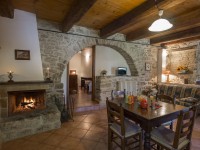Cleaning a wood or coal burning fireplace is important not only to maintain a clean and fresh look of your fire feature, but also to ensure the fire safety in your house. When your fireplace is clean on the inside and on the outside, it’s much more pleasant to sit beside it during cold winter evenings. Naturally, it looks much nicer. In addition to that, it’s much easier to maintain a cheerful fire in a fireplace when it’s clean and free from ash and unusable logs. Finally, clogged chimneys with soot and creosote buildup may lead to terrible fire accidents, which may be avoided as long as fireplace cleanups are carried out by professional chimney servicemen regularly. As difficult as it might seem, fireplace cleaning won’t take too much time and effort. But, as the process is quite messy, it’s still necessary to come up with a certain routine to make it more effective and less unpleasant. So, if you’re thinking about cleaning your fireplace, follow these steps to achieve better results in less time. If you manage to find all tools and supplies listed below, it shouldn’t take you more that 15-20 minutes to conduct this general fireplace cleaning (excluding chimney sweeping, of course).
Brick fireplace cleaning steps
- Most professionals recommend that you should wait 72 hours after the last fireplace burning session before starting any fireplace cleanup actions. But if you’re not going to conduct a throughout cleaning, including chimney, you may wait at least 24 hours after you’ve burned your last fire so the ashes cool thoroughly.
- You’re going to work with ashes. And in general, fireplaces aren’t the cleanest places in people’s houses. That’s why you have to protect yourself, your arms and clothes from turning into the before-meeting-the-prince Cinderella. Put on an apron and protect the floor and maybe even surrounding walls with a plastic tarp not to get your carpet or wooden floors messed up. Get your cleaning supplies and tools ready. You can attempt using just plain water to clean your fireplace. But a heavy spray mix of water and special fireplace cleanser will make the cleaning process much easier and final result – much more impressive. Besides, you won’t go too far without a brick scrubbing tool. So, you may purchase a fireplace cleaning brush or a harsh scrub pad as your main instrument. The only difference is that the brush is much more convenient to work with.
- Collect all your tools and bring them over to the fireplace. Place a comfortable kneeling mat in front of it. Put on rubber gloves not to get your hands all ashy. Extract all logs, old wood flinders and the grate and put them away on the plastic cloth or in a bin bag. Don’t throw away the logs you can still burn. Send others to the trash.
- Scatter a little bit of used coffee grounds over the ashes to prevent them from getting all over the place during the cleanup. However, there’s no need to get rid of wood ashes unless they start smelling weirdly or hampering the fire. Use a fireplace shovel in order to take out the ashes. Throw them into a small bin bag and toss it into the trash.
If you have a wood burning fireplace with an ash dump, you’ll just have to use a shovel or a poker to push the mass through the metal grid on the bottom of the fire pit. Once most of the ashes are gone, vacuum the leftover ashes in the fire box and on the hearth. Take a fireplace brush and clean down the fireplace’s inner wall. Move over to the screens with the same tool once you’re done. Be aware of the fireplace safety and do not try to push hot or even warm coals through the ash dump. Those can ignite a fire in there and cause a terrible accident. - Even if you use the driest firewood in your fireplace, wood burning process will inevitably cause soot and creosote buildup on fireplace’s chimney walls. The matter is that creosote buildup is probably the main cause of those unpredictable chimney fires. And those may burn down the entire house. So, because both substances are highly flammable and thus extremely hazardous, they should be regularly brushed off. If you decide to clean the fireplace’s chimney on your own, you’ll have to wear a respirator not to be exposed to harmful substances for a long period of time. Use a hard-core commercial cleaner designed to clean the soot and smoke stains from different fireplace surfaces and follow the fireplace chimney cleaning instructions from Familyhandyman.com to get the best results. Be aware of the fact that the areas they seat on are quite difficult to reach. Besides, such residue is not too easy to get rid of. So, if you use your fireplace at least once a week during the cold season, you should sign up for an annual chimney examination. Under such circumstances, professional chimney cleanings should be carried out every other year. Therefore, if you put your fireplace to use more frequently, it’s better to conduct a throughout professional fireplace cleaning once or even twice a year. The perfect time to do that is spring and pre-winter cleaning. Go to HireRush.com to find experienced cleaners to deal with your dirty fireplace or post a fireplace cleaning task to get contacted by local chimney sweep servicemen ready to start working as soon as you wish.
- Let’s go back to the regular cleaning. After most of the dirty work is done, you should move on to the fireplace’s exterior. If you have a brick one, spray water all over the grimy areas. Next, apply the hearth cleanser of your choice. If your fireplace is quite old, avoid using heavy cleaning solutions and stick to water not to damage the bricks. Clean the fireplace’s exterior with a clean scrubbing tool, spatter with water. After that, use a soft cloth to dry the area. To clean the iron surfaces, spray them with hearth cleaner, remove it with plain water and rub till dry with paper towels or a microfiber cloth. Marble and stone finishes may be cleaned with water and dish soap mix and dried with an ordinary cloth.
- To make the task easier, you may want to do one section at a time. If you start with one wall, and then move to the next once it is finished, you will make less of a mess, and run into fewer problems. To begin cleaning the walls’ outside, take your heavy cleaning solution and spray it all over the area you’re about to tackle. Follow the manufacturer’s instructions to use that particular cleanser properly. To improve its effect, spray it onto the wall and let it sit there for 10-15 minutes before proceeding to the scrubbing part.
- If your fireplace has glass doors, treat their both sides with a hearth cleaner or effective glass cleaning spray. Work with one panel at a time. Make sure to wipe the cleaning liquid off the glass before it dries.
- To polish fireplace tools and grates, lay them onto the plastic cloth, apply hearth cleaner and wipe them with disposable paper towels.
- To finish cleaning the fireplace, add new logs and a grate. Clean up all the mess you’ve made. Just fold the plastic cloth, collect the bin bags you’ve used and throw them in trash. Close the doors, set the screen and take a look at the work you’ve done. But don’t burn your fireplace just yet. Enjoy that sparkling-clean fireplace for at least a couple of days before turning it into the ashy mess all over again.






Another good tip in cleaning your fireplace would be to do it often. If you do a quick clean of it every week, it won’t be so hard when you decide to deep clean it. There won’t be so much build-up, and it will be easier for you to clean! Plus, if you clean it often, it will always stay looking good.
That’s a great tip, Kendall! It’s definitely better not to allow things get too messy.